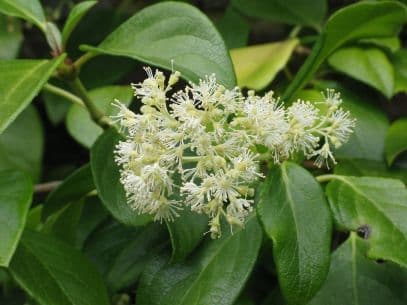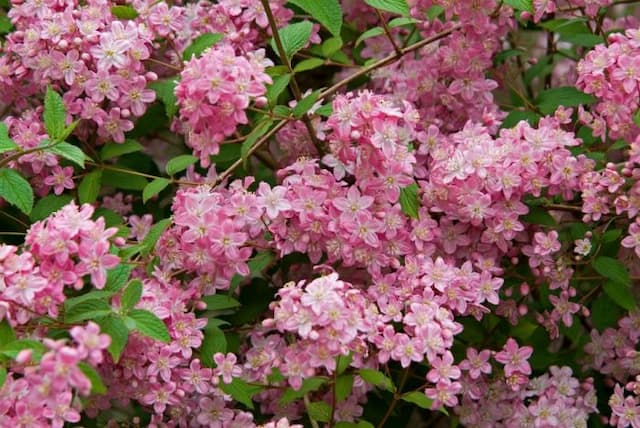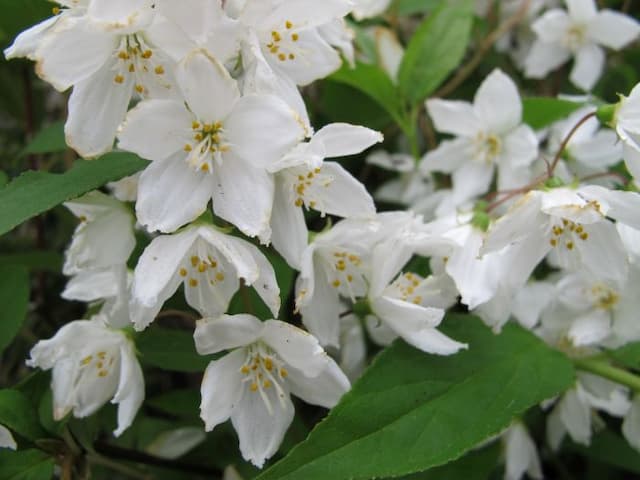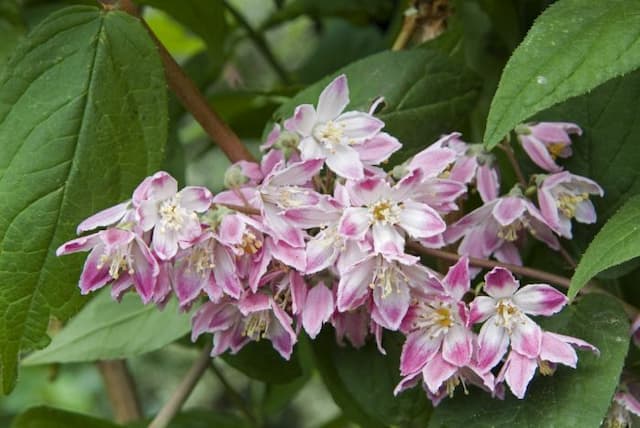Bigleaf Hydrangea Hydrangea macrophylla 'Shining Angel' (PBR) (Black Diamonds Series)

ABOUT
The Hydrangea macrophylla 'Shining Angel' from the Black Diamonds Series is a striking ornamental plant known for its distinctive flowers and dark foliage. The blooms of this eye-catching hydrangea emerge in a vibrant array of colors, typically exhibiting rich shades of pink, violet, or blue, depending on the soil acidity. The flowers are large, rounded clusters, known as mophead flowers, each comprised of numerous small, tightly-packed florets that create a full, lush appearance. Adding to the plant's dramatic presence, the 'Shining Angel' hydrangea has deep black or dark purple stems that contrast starkly with its flowers and foliage. The leaves are dense and leathery with a glossy finish that can range from deep green to nearly black, further accentuating the floral display. This contrast is part of what makes the 'Shining Angel' hydrangea not only a favorite among garden enthusiasts but also a striking choice for landscaping designs focusing on color and texture contrasts. During the blooming season, the plant becomes a focal point in gardens and outdoor spaces. As the season progresses, the flowers may also exhibit a change in color, introducing an evolving palette to the display. This hydrangea's overall visual impact is one of elegance and dramatic flair, making it a popular choice for those looking to add a touch of sophistication to their garden or landscape.
About this plant
 Names
NamesFamily
Hydrangeaceae
Synonyms
Shining Angel Hydrangea, Black Diamonds Shining Angel
Common names
Hydrangea macrophylla 'Shining Angel' (PBR) (Black Diamonds Series).
 Toxicity
ToxicityTo humans
Hydrangeas, including the Hydrangea macrophylla variety, are known to be toxic to humans if ingested. The plant contains compounds such as hydrangenol, which can cause gastrointestinal upset, with symptoms including nausea, vomiting, and diarrhea. In some rare cases, more severe symptoms can occur, such as dizziness, rapid pulse, or even respiratory issues. It is advisable to avoid consuming any part of the hydrangea plant to prevent these potential consequences.
To pets
Hydrangeas, including Hydrangea macrophylla, are also toxic to pets, such as dogs and cats. The toxicity is due to the presence of cyanogenic glycoside in the plant. When pets ingest hydrangea leaves or flowers, they can experience symptoms such as vomiting, diarrhea, lethargy, and depression. In more severe cases, ingestion can lead to increased heart rate, heavy breathing, and even seizures. If you suspect your pet has eaten any part of a hydrangea plant, it's important to seek veterinary care immediately.
 Characteristics
CharacteristicsLife cycle
Perennials
Foliage type
Deciduous
Color of leaves
Green
Flower color
Varies
Height
3-4 feet [91-122 cm]
Spread
3-4 feet [91-122 cm]
Plant type
Shrub
Hardiness zones
5-9
Native area
Japan
Benefits
 General Benefits
General Benefits- Aesthetic Appeal: Adds vibrant colors with its large, shiny, deeply colored leaves and lush flower heads to gardens and landscapes.
- Versatility in Landscaping: Suitable for a variety of garden designs, including borders, foundation plantings, and as a focal point.
- Long Blooming Season: Offers visual interest for a longer period due to its extended blooming time from late spring to fall.
- Attracts Pollinators: Brings butterflies and bees to the garden, which are beneficial for pollination of many plants.
- Adaptability: Can thrive in a range of soil types, though it prefers moist, well-draining conditions.
- Pruning Tolerance: Responds well to pruning and can be easily shaped, allowing gardeners to maintain a desirable size and form.
- Shade Tolerance: Capable of growing in partial shade where many other blooming plants might struggle, increasing gardening options.
- Seasonal Interest: Foliage may take on different hues in autumn, providing additional seasonal interest.
- Easy Propagation: Can be propagated through cuttings, allowing gardeners to create more plants for other areas of the garden or to share with friends.
 Medical Properties
Medical PropertiesThis plant is not used for medical purposes.
 Air-purifying Qualities
Air-purifying QualitiesThis plant is not specifically known for air purifying qualities.
 Other Uses
Other Uses- Hydrangea macrophylla leaves can be used as a natural fabric dye, offering colors ranging from pale green to brown depending on the mordant used.
- The woody stems of the hydrangea, when dried and carved, can be fashioned into intricate small pieces of art or jewelry.
- Petal vein patterns of the hydrangea can be pressed and used in botanical prints for artistic purposes, adding unique texture and design to paper or textiles.
- Hydrangea blooms can be used in potpourri once dried; they retain their shape and add a subtle fragrance to the mix.
- The high level of aluminum in some hydrangea varieties can be used in chemistry experiments to demonstrate the effect of soil pH on plant nutrient uptake.
- The vibrant flowers of the hydrangea make for striking photographic subjects, often used in calendars and postcards to represent the beauty of gardens.
- Hydrangea macrophylla can be used as natural indicators for soil pH; their flower color changes in response to the soil pH levels.
- When dried properly, hydrangea flowers can be used in long-lasting floral arrangements to decorate homes or as part of wreaths and other decor items.
- Large hydrangea leaves can be used as natural wrapping materials for small gifts or as part of eco-friendly craft projects.
- During some cultural festivals, hydrangea flowers can be strung together to create decorative garlands or to adorn traditional costumes.
Interesting Facts
 Feng Shui
Feng ShuiThe hydrangea is not used in Feng Shui practice.
 Zodiac Sign Compitability
Zodiac Sign CompitabilityThe hydrangea is not used in astrology practice.
 Plant Symbolism
Plant Symbolism- Heartfelt Emotions: The 'Shining Angel' Hydrangea commonly symbolizes deep and heartfelt emotions due to its lush and abundant flower heads.
- Gratitude: Giving this hydrangea as a gift can express gratitude or thankfulness, often used to thank someone for their understanding or support.
- Apologetic Gesture: In some cultures, hydrangeas can signify an apology or a desire for reconciliation.
- Boastfulness or Bragging: Historically in Japan, hydrangeas had a negative connotation of boastfulness due to an emperor who gave them as apologies for neglecting the feelings of his subjects.
- Beauty: The strikingly beautiful flowers of this plant can also symbolize vanity or boasting about one’s beauty.
- Variability: The ability of hydrangeas to change color based on the soil acidity can represent change or unpredictability.
- Endurance: As a perennial plant that withstands various climates and blooms annually, the hydrangea can also symbolize perseverance and durability.
 Water
WaterThe Bigleaf Hydrangea should be watered deeply, ensuring the water reaches the roots, about one to two times per week depending on the climate and soil drainage. These plants prefer consistently moist soil, so during dry spells or hot weather, more frequent watering may be necessary, such as every two to three days. Generally, aim for about 1 gallon of water per watering session for each plant, adjusting for weather conditions. During winter, water less frequently, allowing the soil to dry out slightly between watering to prevent root rot.
 Light
LightBigleaf Hydrangeas thrive in a spot with morning sun and afternoon shade, as too much direct sun can scorch their leaves. They can also grow in full shade, however, the blooms may be less prolific. Protection from hot midday sun is particularly critical in warmer climates to maintain the vibrant colors of the flowers.
 Temperature
TemperatureThe Bigleaf Hydrangea is hardy and can tolerate temperatures down to about 5°F, but it thrives best when daytime temperatures are between 65°F and 80°F. These plants can survive up to 95°F, but the foliage may suffer in prolonged heat, especially if not adequately watered. Ideal growing conditions include a location where the plant is shielded from harsh winter winds.
 Pruning
PruningPrune the Bigleaf Hydrangea after it flowers in the late summer to remove spent blooms and any weak or dead branches, which encourages healthy growth and improves the plant's shape. Since hydrangeas flower on old wood, do not prune in the spring as you may cut off the current year's blooms. Pruning every year is not necessary; do so every other year or only when the plant becomes too large or unkempt.
 Cleaning
CleaningAs needed
 Soil
SoilBigleaf Hydrangeas thrive in a soil mix that is rich in organic matter, well-draining yet moist, with an ideal pH range of 5.5 to 6.5. A blend of garden soil, peat moss, and perlite can create an optimal environment for Hydrangea macrophylla 'Shining Angel'.
 Repotting
RepottingBigleaf Hydrangeas should be repotted every 2-3 years or when they outgrow their current pot. The best time to repot is in late winter or early spring, before new growth commences.
 Humidity & Misting
Humidity & MistingBigleaf Hydrangeas prefer moderate to high humidity levels, around 50-60%. They benefit from a humid environment, which can be maintained with regular misting or using a humidifier.
 Suitable locations
Suitable locationsIndoor
Ensure bright, indirect light and maintain soil moisture.
Outdoor
Plant in part-shade, shelter from strong winds, keep soil moist.
Hardiness zone
6-9 USDA
 Life cycle
Life cycleHydrangea 'Shining Angel' begins its life as a dormant bare-root or potted specimen that is planted in early spring or fall. It emerges from dormancy with new growth in the spring, developing lush green foliage and robust stems. During late spring to early summer, it enters its flowering stage, producing large, showy bloom clusters that can range in color from pink to blue depending on soil pH. After blooming, if the flowers are not deadheaded, they may develop into seed heads, though hydrangeas are more commonly propagated through cuttings. As fall approaches, the plant's growth slows, and it begins to prepare for winter dormancy by withdrawing nutrients from the leaves, which change color and eventually drop. Over winter, the hydrangea remains dormant, conserving energy until the next growth cycle begins in spring.
 Propogation
PropogationPropogation time
Spring-Early Summer
Hydrangea macrophylla 'Shining Angel' from the Black Diamonds Series can be propagated most effectively through softwood cuttings. This is typically done in late spring or early summer when the plant's new growth is still tender but has begun to mature slightly. One would cut a 4 to 6-inch (approximately 10-15cm) section of stem from a healthy parent plant just below a leaf node, where the concentration of growth hormones is high. The bottom leaves are then removed, and the cut end dipped in rooting hormone to encourage root development. The cutting is then placed in a pot with a mixture of peat and perlite, ensuring the leaf nodes are buried where roots will form. The environment should be kept humid, often by covering the pot with a plastic bag or placing it in a greenhouse, and within a few weeks, roots should establish, at which point the new hydrangea plant can be gradually acclimated to less humid conditions.






![Rose deutzia [Yuki Cherry Blossom]](/_next/image?url=https%3A%2F%2Fplants-admin.emdemapps.com%2Fimages%2Fplants%2F%2Fimages%2F604b6510a383a.png&w=640&q=75)
![Hydrangea [Hot Chocolate]](/_next/image?url=https%3A%2F%2Fplants-admin.emdemapps.com%2Fimages%2Fplants%2F%2Fimages%2F604b5a066e3bd.png&w=640&q=75)
![Hydrangea [Blackberry Pie]](/_next/image?url=https%3A%2F%2Fplants-admin.emdemapps.com%2Fimages%2Fplants%2F%2Fimages%2F604b56e2abc1d.png&w=640&q=75)
